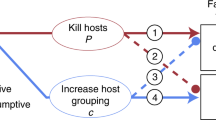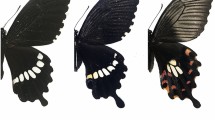Abstract
THE phenomenon of Batesian mimicry, where an edible animal gains an advantage by mimicking a distasteful or dangerous animal showing a warning pattern, is well known and has been described by many authors1–4. The advantage gained by a mimic decreases if the mimetic form becomes too common, since a predator may learn that the warning signal mimicked is a sign of edibility rather than danger; thus selection for the mimic is density-dependent which, as shown by Haldane and Jayakar5, will often lead to a balanced polymorphism where both mimetic and non-mimetic forms are retained in the population. Matessi and Cori6 suggest that mimetic inheritance is often sex-limited so that the expression of mimicry is limited to one sex (usually the female according to Sheppard3) although individuals of the other sex may have the mimetic genotype. It is suggested here that the slow worm (Anguis fragilis L.) has a form of colouration exhibited by the young and some adult females which is a mimic of the warning pattern of the adder (Vipera berus L.).
This is a preview of subscription content, access via your institution
Access options
Subscribe to this journal
Receive 51 print issues and online access
$199.00 per year
only $3.90 per issue
Buy this article
- Purchase on Springer Link
- Instant access to full article PDF
Prices may be subject to local taxes which are calculated during checkout
Similar content being viewed by others
References
Wickler, W., Mimicry (World University Library, London, 1968).
Brown, E. S., New Biology, 10, 72 (1951).
Sheppard, P. M., Natural Selection and Heredity (Hutchinson, London, 1967).
Ford, E. B., Ecological Genetics (Methuen, London, 1964).
Haldane, J. B. S., and Jayakar, S. D., J. Genet., 58, 318 (1963).
Matessi, C., and Cori, R., Theoretical Population Biology, 3, 41 (1972).
Smith, M. A., The British Amphibians and Reptiles (Collins, London, 1951).
Prestt, I., J. Zool., Lond., 164, 373 (1971).
Reid, H. A., Tropical Doctor, 2, 155 (1972).
Manly, B. F. J., Biometrics, 28, 1115 (1972).
Author information
Authors and Affiliations
Rights and permissions
About this article
Cite this article
SMITH, R. Is the Slow Worm a Batesian Mimic?. Nature 247, 571–572 (1974). https://doi.org/10.1038/247571a0
Received:
Revised:
Issue Date:
DOI: https://doi.org/10.1038/247571a0
This article is cited by
-
Viper as a Batesian Model – its Role in an Ecological Community
Biosemiotics (2019)
-
Is the slow worm a Batesian mimic?
Nature (1974)
-
Is the slow worm a Batesian mimic? (reply)
Nature (1974)
Comments
By submitting a comment you agree to abide by our Terms and Community Guidelines. If you find something abusive or that does not comply with our terms or guidelines please flag it as inappropriate.



